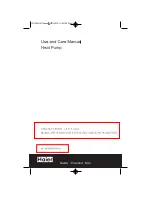
System Start-up
RT-SVX35H-EN
97
Full Modulating Gas Furnace
Full Modulating gas heaters are available for the 500, 850
and 1000 MBH heater sizes. These heaters are available in
the same cabinet sizes as the current heaters. The firing
rate of the unit can vary from the pilot rate of 125 MBH up
to the nameplate rating of the unit. The turn down ratios,
therefore, vary from 4:1 for the 500 MBH to 8:1 for the 1000
MBH heater.
Heat Exchanger
The heat exchanger drum, tubes and front and rear
headers are constructed from stainless steel alloys.
Unit Control
The unit is controlled by a supply air temperature sensor
located in the supply air stream for VAV units. CV units
have two sensors, one located in the supply air stream and
the zone sensor. The temperature sensor signal is sent to
the Heat module of the IntelliPak Unit Control. The control
signal from the Heat Module is an inverse proportional 5
-10V DC. The higher the voltage signal, the lower the call
for heat.
The 5 -10V DC. signal controls the angular position of the
combustion air damper through a direct coupled damper
actuator motor. The position of the air damper in turn
controls the combustion air pressure that is sensed by the
modulating gas valve. The greater the combustion air
pressure, the greater the call for gas and the higher the
firing rate of the heater. As the temperature setpoint is
reached, the Modulating Heat control will cause the
combustion air actuator to change the damper position to
a lower firing rate that matches the heat load of the space.
1. Use
to program the following system
components for operation by scrolling through the
Human Interface displays;
Gas Heat
•
Supply Fan (On)
•
Variable Frequency Drive (100% Output, if appli
cable)
•
RTM Occ/Unocc Output (Unoccupied)
•
High Fire (90%)
•
Turn the 115 volt control circuit switch 4S24 located
in the heater control panel to the "On" position.
•
Open the manual gas valve, located in the gas heat
section.
2. Once the configuration for the appropriate heating
system is complete, press the NEXT key until the LCD
displays the “Start test in __Sec.” screen. Press the +
key to designate the delay before the test is to start.
This service test will begin after the TEST START key is
pressed and the delay designated in this step has
elapsed. Press the ENTER key to confirm this choice.
3. Press the TEST START key to start the test. Remember
that the delay designated in the previous step must
elapse before the system will begin to operate.
4. Once the system has started, check the appearance of
the flame through the sight glass provided on the front
of the heat exchanger. In appearance, a normal flame
has a clearly defined shape, and is primarily (75%) blue
in color with an orange tip.
5. Check the inlet gas pressure at the modulating gas
valve. The inlet pressure should be 6" to 8" w.c.
6. Use a CO
2
analyzer and measure the percentage of CO
2
in the flue gas. Refer to the illustration in
. Take several samples to assure that an accurate
reading is obtained. If the measured CO
2
level is
between 8.0 and 9.5%, no adjustment is necessary. If
the CO
2
is outside this range, it indicates incomplete
combustion due to inadequate air or excessive gas.
The pressure ratio and bias adjustment screws are
located on top of the regulator under a sealed plate.
The actual settings can be seen through windows on
each side of the regulator. Refer to the illustration in
Note:
The burner capacity is controlled by the movement
of the air damper. This has been preset at the
factory and normally does not need field
adjustment. The combustion quality (air/gas) is
controlled by the settings on the regulator (the plus
(+) and minus (-) indications relate to the change in
gas flow.
7. Set the air/gas ratio to the desired value using the #1
adjustment screw until the optimum values between
(8.0 and 9.5%) are obtained (course setting).
8. Use
firing rate. Allow the system to operate for
approximately 10 minutes.
9. Use a CO
2
analyzer and measure the percentage of CO
2
in the flue gas. If the measured CO
2
level is between 6.0
and 8.0%, no adjustment is necessary. If an adjustment
is needed, turn the #2 adjustment screw on the
regulator in the Plus (+) direction to increase the CO
2
and in the Minus (-) direction to decrease the CO
2
. Refer
location.
Note:
It is normal for the low fire CO
2
to be lower than the
high fire.
10. If the measured CO
2
level is below the recommended
values for low heat, return the burner to 90% fire rate
and repeat steps 6 and 7, to achieve optimum
combustion.
11. Program the burner for 100% operation and recheck
the CO
2
or O
2
value.
12. Check the flue gas values at several intermediate
output levels. If corrections are necessary;
–
Adjust the pressure ratio screw 1 at high fire
operation only.
–
Adjust the bias screw 2 at low fire operation
only.
Summary of Contents for IntelliPak WEHE Series
Page 15: ...General Information RT SVX35H EN 15 Figure 1 Unit component layout and ship with locations...
Page 17: ...Installation RT SVX35H EN 17 Figure 2 Typical control module location...
Page 44: ...Installation 44 RT SVX35H EN Figure 27 Typical field power wiring for W_HE casings 2 through 6...
Page 56: ...Installation 56 RT SVX35H EN Figure 32 Wiring notes for CV controls...
Page 60: ...Installation 60 RT SVX35H EN Figure 35 Wiring notes VAV...
Page 68: ...System Start up 68 RT SVX35H EN Figure 38 Typical fenwall ignition control system...
Page 69: ...System Start up RT SVX35H EN 69 Figure 39 Typical Fenwall ignition control system...







































